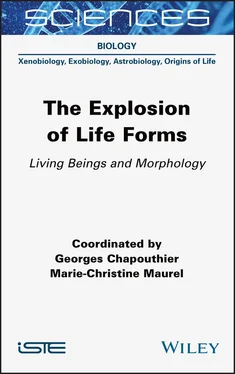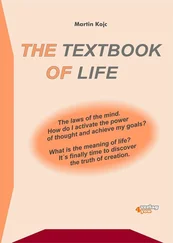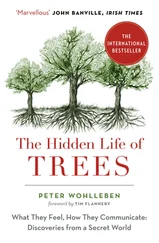What can we deduce from these observations regarding our knowledge of the reproduction of the ancestors of today’s bacteria?
Briers et al . (2012) studied the gap between the first protocell and the hypothetical cell ancestor named “Luca”. Although there are striking coincidences between the two behaviors, the similarities observed still deserve long studies to confirm an ancestral morphological link and the understanding of the origins of unicellular life.
1.6. Rebuilding a living cell: a wide range of possibilities explored, from the mineral to the organic
Today, we speak of “chemical gardens” and “metallic vegetation” to refer to self-organized chemical figures that evoke plant diversity. When a metal salt is brought into contact with a basic aqueous solution of silicate, carbonate or phosphate, patterns called “flowers” are produced in the laboratory (Haudin et al . 2018). Technological innovations are suggested by these natural mineral productions which flourish today in the field of biomimicry. They find multiple biophysical, robotic, electronic, automatic, aeronautical, architectural, etc. applications, with the purpose of compensating for our weaknesses and repairing handicaps. Let us note here that mimicry is not the prerogative of modern technologies. A spider can be mistaken, even by the greatest arachnologist, for a fragment of a dead leaf.
The mechanobiology of biological membranes has become a growing field of research, particularly in the field of synthetic biology, towards artificial cells with genetic circuits and reaction cascades. Maximizing the modularity of their design and their flexibility is made possible by encapsulating them in liposomes, allowing chemical reactions to take place in well isolated environments. Such minimal synthetic cells, called “synells”, were designed by MIT researchers 3, who founded Synlife in 2017. They are governed by external signals and communication between liposomes, which can be fused in a controlled manner (Adamala et al . 2016).
Artificial life, in silico, a new paradigm between the machine and the living, serves as a model for the design of mineral “creatures”, organoids, automata (mechanical or bionic), micro-robots with metabolisms (Hamada et al . 2019), humanoids, etc., which would “emerge” from nanotechnology. The pairing of the brain and machine aims at the illusory perfection of the human species aspiring, as described by Aldous Huxley in 1932 in Brave New World , to impose its path to evolution.
Seeking to understand how life appeared on Earth also means looking for the fossil traces of the first cells, which inevitably leads to the question of how big the smallest living organism is (implied: the smallest being the simplest, therefore the first to appear on Earth). In connection with genomics work, Craig Venter (director of the Institute for Genomic Research – TIGR 4– in Rockville, Maryland) and Hamilton Smith (who won the Nobel Prize in 1978 for the co-discovery of restriction enzymes) have removed the genes of Mycoplasma genitalium one by one, reputed to have the smallest known genome. The aim is to obtain a viable organism with the minimum number of genes, Mycoplasma laboratorium , making it possible to develop, in fine, the smallest living organism possible: “The goal is to fundamentally understand the components of the most basic living cell” (Singer 2007). This approach raises one of the most delicate problems in contemporary biology: what consequences can the manufacture of such objects have on the future of humanity, the biosphere, the environment and the planet? Is there a risk of unbalancing ecosystems?
Producing organisms that are “outside the norm”, in the technical sense, employs us to think about the standardization of criteria for living things, the quality of life, and lastly, the normativity of living things (what does “being normal” mean?). In 1995, Jean-Pierre Séris declared that it was impossible to set standards of vital value: “Uniformity, the reproduction of that which is identical has a meaning and a technical value. It has no biological value. It is biological nonsense ...”
Our thanks go to Ariel Anbar, Jeff Errington, Primož Peterlin, Pierre Thomas and Peter Walde, who kindly provided us with the figures and photographs (Figures 1.1 to 1.5), and to Jacques Vergne and Louis Ter-Ovanessian for their careful reading.
Adamala, K., Szostak, J.W. (2013). Competition between model protocells driven by an encapsulated catalyst. Nature Chemistry , 5(6), 495–501.
Adamala, K.P., Martin-Alarcon, D.A., Guthrie-Honea, K.R., Boyden, E.S. (2016). Engineering genetic circuit interactions within and between synthetic minimal cells. Nature Chemistry , 9, 431–439.
Adriaenssens, E.M., Sullivan, M.B., Knezevic, P., van Zyl, L.J., Sarkar, B.L., Dutilh, B.E., Alfenas-Zerbini, P., Lobocka, M., Tong, Y., Brister, J.R., Moreno Switt, A.I., Klumpp, J., Karam Aziz, R., Barylski, J., Uchiyama, J., Edwards, R.E., Kropinski, A.M., Petty, N.K., Clokie, M.R.J., Kushkina, A.I., Morozova, V.V., Duffy, S., Gillis, S., Rumnieks, J., Kurtböke, I., Chanishvili, N., Goodridge, L., Wittmann, J., Lavigne, R., Bin Jang, H., Prangishvili, D., Enault, F., Turner, D., Poranen; M.M., Oksanen, H.M., Krupovic. M. (2020). Taxonomy of prokaryotic viruses: 2018–2019 update from the ICTV Bacterial and Archaeal Viruses Subcommittee. Archives of Virology , 165, 1253–1260.
Allwood, A.C., Walter, M.R., Kamber, B.S., Marshall, C.P., Burch, I.W. (2006). Stromatolite reef from the early Archaean era of Australia. Nature , 441, 714–718.
Anbar, A.D. (2008). Elements and evolution. Science , 322, 1481–1483.
Atlan, H. (1972). L’Organisation biologique et la théorie de l’information . Hermann, Paris.
Awramik, S.M. (1994). The history and significance of stromatolites. In Early Organic Evolution: Implications for Mineral and Energy Resources , Schidlowski, M. et al . (eds). Springer, Berlin, 435–449.
Bernard, C. (1878) . Leçons sur les phénomènes de la vie communs aux animaux et aux végétaux . Librairie Baillière et fils, Paris.
Briers, Y., Walde, P., Schuppler, M., Loessner, M.J. (2012). How did bacterial ancestors reproduce? Lessons from L-form cells and giant lipid vesicles. Bioessays , 34, 1078–1084.
Bungenberg de Jong, H.G. (1936). La coacervation. Les coacervats et leur importance en biologie . Hermann & cie, Paris.
Callahan, M.P., Smith, K.E., Cleaves II, H.J., Ruzicka, J., Stern, J.C., Glavin, D.P., House, C.H., Dworkin, J.P. (2011). Carbonaceous meteorites contain a wide range of extraterrestrial nucleobases. PNAS, USA , 108(34), 13995–13998.
Chen, I.A., Szostak, J.W. (2004). Membrane growth can generate a transmembrane pH gradient in fatty acid vesicles. PNAS, USA , 101(21), 7965–7970.
Damer, B., Deamer, D. (2015). Coupled phases and combinatorial selection in fluctuating hydrothermal pools: a scenario to guide experimental approaches to the origin of cellular life. Life (Basel) , 5(1), 872–887.
Deamer, D.W. (1985). Boundary structures are formed by organic components of the Murchison carbonaceous chondrite. Nature , 317, 792–794.
Deamer, D.W. (1997). The first living systems: a bioenergetic perspective. Microbiol. Mol. Biol. Rev ., 61, 230–261.
Deamer, D.W., Barchfeld, G.L. (1982). Encapsulation of macromolecules by lipid vesicles under simulated prebiotic conditions. J. Mol. Evol ., 18, 203–206.
Deamer, D.W., Pashley, R.M. (1989). Amphiphilic components of carbonaceous meteorites. Orig. Life Evol. Biosph ., 19, 21–33.
Читать дальше












